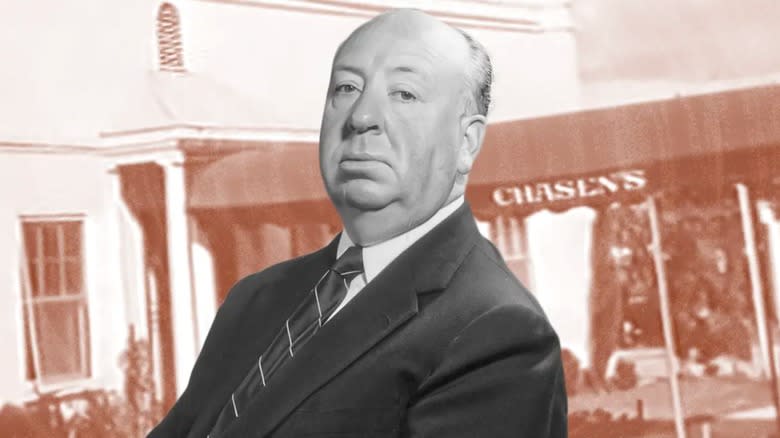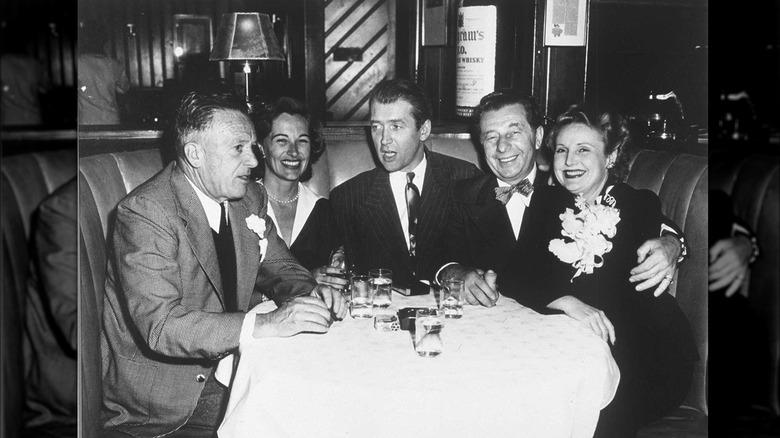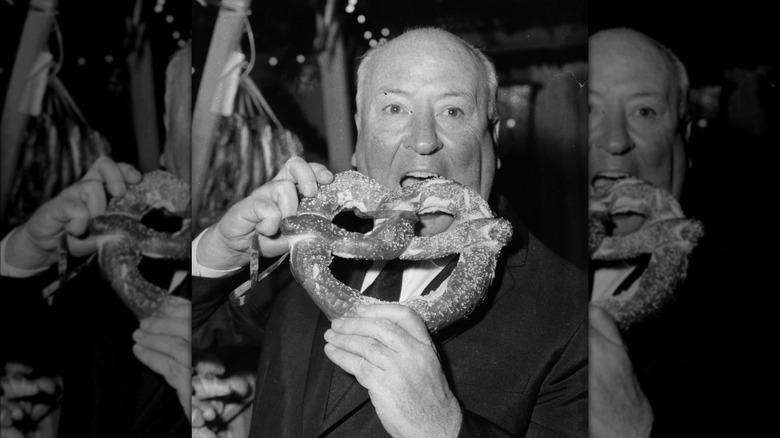Alfred Hitchcock's Favorite Steak Dinner Was Hollywood's Iconic Chasen's

Here at Tasting Table, we're all about celebrating the duality of man (sweet and salty, anyone?). In today's historical deep-dive, it turns out that the Master of Suspense was also a legendary gourmand. Alfred Hitchcock's appetite for suspense was only rivaled by his appetite for steak.
Per the lore, when Hitchcock went to Hollywood, he brought his personal cook with him. As he is quoted in The Writer's Almanac, Hitchcock once declared, "There is as much anticipation in confronting good food as there is in going on a holiday or seeing a good show. There are two kinds of eating -- eating to sustain and eating for pleasure. I eat for pleasure." Per the almanac, three steaks and three bowls of ice cream were an average dinner for the director. He also reportedly had a penchant for Burgundy wines. But, when he was going out for a steak dinner, he was going to Chasen's.
Hitchcock's usual Chasen's order was a $5.50 "double steak" washed down with champagne punch. In 1955, the year "To Catch a Thief" hit the Hollywood big screen, $5.50 was the equivalent of about $63 today. Hitchcock was such a regular, in fact, that he had his own booth at Chasen's (as did Howard Hughes and Jimmy Stewart, the latter of whom starred in four Hitchcock films). Legend has it that, a few dozen ounces of beef later, Hitchcock was regularly spotted falling asleep at the table -- arguably the best dessert after a terrific, filling meal.
Read more: Restaurant Foods That Always Taste Better Than What You Make At Home
Chasen's As The Cornerstone Of Artistic Appetites

Chasen's is revered as one of the "Big Three" celebrity-haunt restaurants of old Hollywood movie stars on the Sunset Strip (besides Perino's and the Brown Derby), and it's no mystery why the joint was so widely beloved. The name of the game at Chasen's was American/Continental fare in enormous portions. Lush seafood platters, hobo steaks, cheese toast appetizers, a sprawling buffet complete with beluga caviar (at $4.50 per ounce), and a legendary chili made with a top-secret proprietary recipe were regular fixtures. The filet mignon and the eastern prime New York steak both cost $5.25, and customers could get an entire rack of lamb for $9.
The upscale interior was decorated with red upholstered furniture, leather booths, and framed photos of the Hollywood elite of the era, and was manned by tuxedo-clad waiters. At one time, Chasen's was even outfitted with a sauna and a full-time barber. Indeed, for many hyper-public socialites, Chasen's was a haven of luxury-meets-comfort. Per the lore, a homesick Elizabeth Taylor once spent $100 to have a pint of Chasen's chili shipped to Rome while she was on set filming "Cleopatra" in 1962.
Hollywood History Made Over The Dinner Table

In an interview with NPR, Tippi Hedren said that it was at Chasen's where the director offered her the leading role in "The Birds" (1963). Hitchcock and his wife Alma also held their joint 75th birthday party at the restaurant in 1974 (another legendary director, Francois Truffaut, attended).
Chasen's was also a favorite haunt of Frank Sinatra, Clark Gable, Groucho Marx, Johnny Carson, Orson Welles, Bing Crosby, Humphrey Bogart, George Burns, Bob Hope, Great Garbo, and Cary Grant (who also starred in four Hitchcock flicks). In short, if you were "somebody" in Hollywood during the 1930s to 1960s, you dined at Chasen's. Hitchcock's long hours spent tableside might have inspired the beautifully-staged upscale culinary scenes that feature prominently in his films, from the exploration of Moroccan dining etiquette in "The Man Who Knew Too Much" (1956) to the lobster frites in "Rear Window" (1954), a dish which takes on a much deeper meaning than just a luscious meal.
The restaurant at 9039 Beverly Boulevard opened in December 1936 and was run by husband and wife duo Dave and Maude Chasen until Dave's passing in 1973. Dave Chasen was himself a comedian and vaudeville performer, and Hitchcock was reportedly in attendance at Chasen's funeral. Chasen's closed in 1995, 15 years after Hitchcock's passing in 1980.
Read the original article on Tasting Table.
